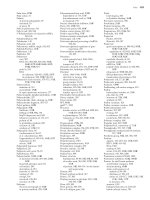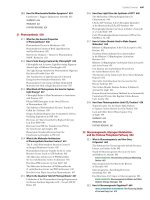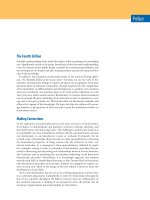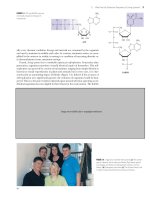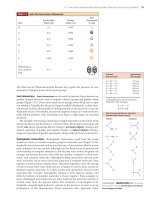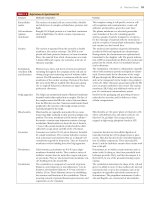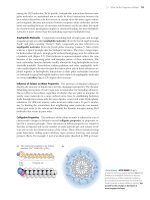Biochemistry, 4th Edition P53 ppsx
Bạn đang xem bản rút gọn của tài liệu. Xem và tải ngay bản đầy đủ của tài liệu tại đây (1.25 MB, 10 trang )
16.2 What Is the Molecular Mechanism of Muscle Contraction? 483
1 to 2 m in diameter. Myofibrils are linear arrays of cylindrical sarcomeres, the
basic structural units of muscle contraction. Each myofibril is surrounded by a spe-
cialized endoplasmic reticulum called the sarcoplasmic reticulum (SR). The SR con-
tains high concentrations of Ca
2ϩ
, and the release of Ca
2ϩ
from the SR and its
interactions within the sarcomeres trigger muscle contraction. The muscle fiber is
surrounded by the sarcolemma, a specialized plasma membrane. Extensions of the
sarcolemma, called transverse tubules, or t-tubules, reach deep into the muscle fiber,
enabling the sarcolemmal membrane to be in contact with each myofibril.
Skeletal muscle contractions are initiated by nerve stimuli that act directly on the
muscle. Nerve impulses produce an electrochemical signal (see Chapter 32) called
an action potential that spreads over the sarcolemmal membrane and into the fiber
along the t-tubule network. This signal induces the release of Ca
2ϩ
ions from the SR.
These Ca
2ϩ
ions bind to proteins within the muscle fibers and induce contraction.
The Molecular Structure of Skeletal Muscle Is Based on Actin
and Myosin
Examination of myofibrils in the electron microscope reveals a banded or striated
structure. The bands are traditionally identified by letters (Figure 16.2). Regions of
high electron density, denoted A bands, alternate with regions of low electron den-
sity, the I bands. Small, dark Z lines lie in the middle of the I bands, marking the
ends of the sarcomere. Each A band has a central region of slightly lower electron
density called the H zone, which contains a central M disc (also called an M line).
Electron micrographs of cross sections of each of these regions reveal molecular de-
tails. The H zone shows a regular, hexagonally arranged array of thick filaments of
myosin (15 nm diameter), whereas the I band shows a regular, hexagonal array of
thin filaments of actin, together with proteins known as troponin and tropomyosin
(7 nm diameter). In the dark regions at the ends of each A band, the thin and thick
I band I bandA band
Z line Z lineH zone
One sarcomere
Thin filaments Thick filaments Thick and thin
filaments
M disc
FIGURE 16.2 Electron micrograph of a skeletal muscle
myofibril (in longitudinal section).The length of one
sarcomere is indicated, as are the A and I bands, the H
zone, the M disc, and the Z lines. Cross sections from the
H zone show a hexagonal array of thick filaments,
whereas the I band cross section shows a hexagonal
array of thin filaments.
Courtesy of Hugh Huxley, Brandeis University
484 Chapter 16 Molecular Motors
filaments interdigitate, as shown in Figure 16.2. The thin and thick filaments are
joined by cross-bridges. These cross-bridges are actually extensions of the myosin
molecules, and muscle contraction is accomplished by the sliding of the cross-
bridges along the thin filaments, a mechanical movement driven by the free energy
of ATP hydrolysis.
The Composition and Structure of Thin Filaments Actin, the principal component
of thin filaments, is found in substantial amounts in most eukaryotic cells. At low ionic
strength, actin exists as a 42-kD globular protein, denoted G-actin (Figure 16.3). Un-
der physiological conditions (higher ionic strength), G-actin polymerizes to form a fi-
brous form of actin, called F-actin. As shown in Figure 16.4, F-actin is a right-handed
helical structure, with a helix pitch of about 72 nm per turn. The F-actin helix is the
core of the thin filament, to which tropomyosin and the troponin complex also add.
Tropomyosin winds around actin filaments and prevents myosin binding in resting
muscle. When a nerve impulse arrives at the sarcolemmal membrane, Ca
2ϩ
ions re-
leased from the sarcoplasmic reticulum bind to the troponin complex, inducing a
conformation change that allows myosin to bind to actin, initiating contraction. In
nonmuscle cells, actin filaments are the highways across which a variety of cellular
cargo is transported.
The Composition and Structure of Thick Filaments Myosin, the principal compo-
nent of muscle thick filaments, is a large protein consisting of six polypeptides, with
an aggregate molecular weight of approximately 540 kD. As shown in Figure 16.5, the
six peptides include two 230-kD heavy chains, as well as two pairs of different 20-kD
light chains, denoted LC1 and LC2. The heavy chains consist of globular amino-
terminal myosin heads, joined to long ␣-helical carboxy-terminal segments, the tails.
These tails are intertwined to form a left-handed coiled coil approximately 2 nm in
diameter and 130 to 150 nm long. Each of the heads in this dimeric structure is asso-
Globular
heads
Light chains
Coiled-coil rod
Converter domain
Relay helix
2 nm
COO
–
COO
–
NH
3
+
NH
3
+
(a)
(b)
150 nm
FIGURE 16.5 (a) A schematic drawing of a myosin hexamer, showing the two heavy chains
and four light chains.The tail is a coiled coil of intertwined ␣-helices extending from the two
globular heads. One of each of the myosin light-chain proteins, LC1 and LC2, is bound to each of
the globular heads. (b) A ribbon diagram shows the structure of the myosin head.The head and
neck domains of the heavy chain are red; the essential light chain is yellow and the regulatory
light chain is blue (pdb id ϭ 1B7T).
FIGURE 16.3 The three-dimensional structure of an
actin monomer from skeletal muscle. This view shows
the two domains (left and right) of actin
(pdb id ϭ 1J6Z).
FIGURE 16.4 A molecular model of an actin polymer,
based on the actin monomer structure shown in
Figure 16.3 (pdb id ϭ 1A5X).
16.2 What Is the Molecular Mechanism of Muscle Contraction? 485
ciated with an LC1 and an LC2. The myosin heads exhibit ATPase activity, and hy-
drolysis of ATP by the myosin heads drives muscle contraction. LC1 is also known as
the essential light chain, and LC2 is designated the regulatory light chain. Both light
chains are homologous to calmodulin and troponin C. Dissociation of LC1 from the
myosin heads by alkali cations results in loss of the myosin ATPase activity.
The myosin head consists of a globular domain, where ATP is bound and hy-
drolyzed, and a long ␣-helical neck, to which the light chains are bound. The most
prominent feature of the globular head is the actin-binding cleft between the so-
called upper and lower domains. The N-terminal domain and the upper domain to-
gether form a seven-stranded -sheet. The ATP-binding site is partially defined by
three loops: switch 1, switch 2, and the P-loop. Conformation changes driven by
ATP hydrolysis cause a rotation of the converter domain and the long-neck helix—
the fundamental event in contraction.
Repeating Structural Elements Are the Secret of Myosin’s Coiled Coils Several
key features of the myosin sequence are responsible for the ␣-helical coiled coils
formed by myosin tails. Several orders of repeating structure are found in all myosin
tails, including 7-residue, 28-residue, and 196-residue repeating units. Large
stretches of the tail domain are composed of 7-residue repeating segments. The first
and fourth residues of these 7-residue units are generally small, hydrophobic amino
acids, whereas the second, third, and sixth are likely to be charged residues. The
consequence of this arrangement is shown in Figure 16.6. Seven residues form two
turns of an ␣-helix, and in the coiled coil structure of the myosin tails, the first and
fourth residues face the interior contact region of the coiled coil. Residues b, c, and
f (2, 3, and 6) of the 7-residue repeat face the periphery, where charged residues
can interact with the water solvent. At the 28 (4 ϫ 7) residue and 196 (28 ϫ 7)
residue levels, specialized amino acid sequence patterns promote packing of large
numbers of myosin tails in offset or staggered arrays (Figure 16.7).
a
d
d
a
b
c
c
b
e
g
f
f
g
e
FIGURE 16.6 An axial view of the two-stranded, ␣-helical
coiled coil of a myosin tail. Hydrophobic residues a and
d of the 7-residue repeat sequence align to form a
hydrophobic core. Residues b, c, and f face the outer sur-
face of the coiled coil and are typically ionic.
A DEEPER LOOK
The P-Loop: A Common Motif in Enzymes That Hydrolyze Nucleoside Triphosphates
Skeletal muscle myosin is just one member of a large class of en-
zymes that convert the free energy of NTP hydrolysis into chemi-
cal signaling, mechanical work, or both. These enzymes all employ
a polypeptide loop between a -strand and an ␣-helix with the
sequence GxxxxGK(S/T) or GxxGK(S/T). This sequence, the so-
called P-loop, coordinates the triphosphate chain of the NTP to be
cleaved. Side-chain (lysine amino and serine/threonine–OH)
groups, as well as backbone (amide–NH) groups of the P-loop,
position the - and ␥-phosphate groups of the substrate so as to
facilitate hydrolysis. Genomic analysis reveals that 10% to 18% of
predicted gene products are P-loop NTPases. P-loops are found in
a variety of motor proteins, including myosins and kinesins, as well
as in the ABC ATPases (see Chapter 9), the AAAϩ ATPases (see
Section 16.4), the F1 ATPase (a rotary motor; see Chapter 20), the
GTP-binding proteins known as G-proteins (for example, EF-Tu
discussed in Chapter 30 and Ras discussed in Chapter 32), and
adenylate kinase (see Chapter 27).
Myosin heads Bare zone
Location of M disc region
FIGURE 16.7 The packing of myosin molecules in a thick
filament. Adjoining molecules are offset by approxi-
mately 14 nm, a distance corresponding to 98 residues
of the coiled coil.
ᮣ
P-loops of histidine
permease (pdb id ϭ 1B0U,
orange) and HprK protein
kinase (pdb id ϭ 1KKL, green).
ATP is shown in light blue.
Go to CengageNOW at
www.cengage.com/login and click
BiochemistryInteractive to explore myosin.
486 Chapter 16 Molecular Motors
The Mechanism of Muscle Contraction Is Based on Sliding Filaments
When muscle fibers contract, the thick myosin filaments slide or walk along the thin
actin filaments. The basic elements of the sliding filament model were first de-
scribed in 1954 by two different research groups: Hugh Huxley and his colleague
Jean Hanson, and the physiologist Andrew Huxley and his colleague Ralph
Niedergerke. Several key discoveries paved the way for this model. Electron micro-
scopic studies of muscle revealed that sarcomeres decreased in length during con-
traction and that this decrease was due to decreases in the width of both the I band
and the H zone (Figure 16.8). At the same time, the width of the A band (which is
the length of the thick filaments) and the distance from the Z discs to the nearby H
zone (that is, the length of the thin filaments) did not change. These observations
made it clear that the lengths of both the thin and thick filaments were constant
during contraction. This conclusion was consistent with a sliding filament model.
The Sliding Filament Model The shortening of a sarcomere (Figure 16.8) involves
sliding motions in opposing directions at the two ends of a myosin thick filament. Net
HUMAN BIOCHEMISTRY
The Molecular Defect in Duchenne Muscular Dystrophy Involves
an Actin-Anchoring Protein
Duchenne muscular dystrophy is a degenerative and fatal disorder
of muscle affecting approximately 1 in 3500 boys. Victims of
Duchenne dystrophy show early abnormalities in walking and run-
ning. By the age of 5, the victim cannot run and has difficulty stand-
ing, and by early adolescence, walking is difficult or impossible.
The loss of muscle function progresses upward in the body, affect-
ing next the arms and the diaphragm. Respiratory problems or in-
fections usually result in death by the age of 30. Louis Kunkel and
his co-workers identified the Duchenne muscular dystrophy gene
in 1986. This gene produces a protein called dystrophin, which is
highly homologous to ␣-actinin and spectrin. A defect in dys-
trophin is responsible for the muscle degeneration of Duchenne
dystrophy.
Dystrophin is located on the cytoplasmic face of the muscle
plasma membrane, linked to the plasma membrane via an integral
membrane glycoprotein. Dystrophin has a high molecular mass
(427 kD) but constitutes less than 0.01% of the total muscle protein.
It folds into four principal domains (see accompanying figure, part
a), including an N-terminal domain similar to the actin-binding do-
mains of actinin (in muscle) and spectrin (in red blood cells), a long
repeat domain, a -dystroglycan-binding domain, and a C-terminal
domain that is unique to dystrophin. The repeat domain consists of
24 triple-helical repeat units of approximately 109 residues each.
“Spacer sequences” high in proline content, which do not align with
the repeat consensus sequence, occur at the beginning and end of
the repeat domain. Spacer segments are found between repeat ele-
ments 3 and 4 and 19 and 20. The high proline content of the spac-
ers suggests that they may represent hinge domains. The spacer/
hing
e segments are sensitive to proteolytic enzymes, indicating that
they may represent more exposed regions of the polypeptide. The
N-terminal actin-binding domain appears capable of binding to 24
actin monomers in a polymerized actin filament.
(a)
␣-Actinin
␣-Spectrin
N
Actin-
binding
domain
-Dystroglycan–
binding domain
-Dystroglycan–
binding domain
-Dystroglycan–
binding domain
C-terminal
domain
Long spectrin repeat domain
Actin-
binding
domain
A comparison of the amino acid sequence of dystrophin, ␣-actinin, and spectrin. The potential
hinge segments in the dystro
p
hin structure are indicated.
Hinge 1 Hinge 2 Hinge 3 Hinge 4
1N
N
23 456789101112
1234
1234 C
56789 1011121314151617181920
C
13 14 15 16 17 18 19 20 21 C22 23 24
Dystrophin
16.2 What Is the Molecular Mechanism of Muscle Contraction? 487
Dystrophin itself appears to be part of an elaborate protein–
glycoprotein complex that bridges the inner cytoskeleton (actin fil-
aments) and the extracellular matrix (via a matrix protein called
laminin) (see figure). It is now clear that defects in one or more
of the proteins in this complex are responsible for many of the
other forms of muscular dystrophy. The glycoprotein complex is
composed of two subcomplexes, the dystroglycan complex and
the sarcoglycan complex. The dystroglycan complex consists of
␣-dystroglycan, an extracellular protein that binds to merosin, a
laminin subunit and component of the extracellular matrix, and
-dystroglycan, a transmembrane protein that binds the C-terminal
domain of dystrophin inside the cell (see figure). The sarcoglycan
complex is composed of ␣-, -, and ␥-sarcoglycans, all of which are
transmembrane glycoproteins. Alterations of the sarcoglycan pro-
teins are linked to limb-girdle muscular dystrophy and autosomal
recessive muscular dystrophy. Mutations in the gene for merosin,
which binds to ␣-dystroglycan, are linked to severe congenital mus-
cular dystrophy, yet another form of the disease.
(b)
-DG
␣-DG
-SG
␥-SG
␣-SG
Laminin
Hinges
Hinges
N-terminus
Cytoskeletal
F-actin
Spectrin
repeats
Basal lamina
-Dystroglycan–
binding domain
Dystro
p
hin
C-terminus
ᮤ
A model for the actin–dystrophin–glycoprotein complex
in skeletal muscle. Dystrophin is postulated to form tetramers
of antiparallel monomers that bind actin at their N-termini
and a family of dystrophin-associated glycoproteins at their
C-termini. This dystrophin-anchored complex may function
to stabilize the sarcolemmal membrane during contraction–
relaxation cycles, link the contractile force generated in the
cell (fiber) with the extracellular environment, or maintain
local organization of key proteins in the membrane. The
dystrophin-associated membrane proteins (dystroglycans,
DGs, and sarcoglycans, SGs) range from 25 to 154 kD.
(Adapted from Ahn, A. H., and Kunkel, L. M., 1993. Nature Genetics
3:283–291; and Worton, R., 1995. Science 270:755–756.)
A band I band
H zone
H zone and I band decrease in width
Relaxed
Z line
Contracted
FIGURE 16.8 The sliding filament model of skeletal
muscle contraction.The decrease in sarcomere
length is due to decreases in the width of the I band
and H zone, with no change in the width of the A
band.These observations mean that the lengths of
both the thick and thin filaments do not change
during contraction. Rather, the thick and thin fila-
ments slide along one another.
488 Chapter 16 Molecular Motors
sliding motions in a specific direction occur because the thin and thick filaments both
have directional character. Actin filaments always extend outward from the Z lines in a
uniform manner. The myosin thick filaments also assemble in a directional manner.
The polarity of myosin thick filaments reverses at the M disc, which means that actin
filaments on either side of the M disc are pulled toward the M disc during contraction
by the sliding of the myosin heads, causing net shortening of the sarcomere.
Albert Szent-Györgyi’s Discovery of the Effects of Actin on Myosin The molecular
events of contraction are powered by the ATPase activity of myosin. Much of our pre-
sent understanding of this reaction and its dependence on actin can be traced to sev-
eral key discoveries by Albert Szent-Györgyi at the University of Szeged in Hungary in
the early 1940s.
In a series of elegant and insightful experiments, Szent-Györgyi showed the
following:
• Solution viscosity is increased dramatically when solutions of myosin and
actin are mixed. Increased viscosity is a manifestation of the formation of an
actomyosin complex.
• The viscosity of an actomyosin solution is lowered by the addition of ATP, indi-
cating that ATP decreases myosin’s affinity for actin.
• Myosin ATPase activity is increased substantially by actin. (For this reason, Szent-
Györgyi gave the name actin to the thin filament protein.) The ATPase turnover
number of pure myosin is 0.05/sec, but when actin is added, the turnover num-
ber increases to about 10/sec, a number more like that of intact muscle fibers.
Szent-Györgyi’s experiments demonstrated that ATP hydrolysis and the associa-
tion and dissociation of actin and myosin are coupled. It is this coupling that en-
ables ATP hydrolysis to power muscle contraction.
The Coupling Mechanism: ATP Hydrolysis Drives Conformation Changes in the
Myosin Heads The only remaining piece of the puzzle is this: How does the close
coupling of actin-myosin binding and ATP hydrolysis result in the shortening of
myofibrils? Put another way, how are ATP hydrolysis and the sliding filament model
related? The answer to this puzzle is shown in Figure 16.9. The free energy of ATP
Attached
Power
ATP hydrolysis
and recovery
Resting muscle
Rigor-like Top-of-power stroke
Post rigor Pre-power stroke
Detached
ATP
ATP
P
i
, ADP
P
i
ADP
P
i
ADP
Switch 1 open
Switch 2 closed
A
ctin-cleft closed
-sheet twisted
Switch 1 open
Switch 2 closed
Actin-cleft closed
-sheet twisted
Switch 1 open
Switch 2 open
A
ctin-cleft open
-sheet untwisted
Switch 1 closed
Switch 2 closed
Actin-cleft half closed
-sheet untwisted
1
4
2
3
ACTIVE FIGURE 16.9 The mechanism of skeletal muscle contraction.The free energy of ATP
hydrolysis drives a conformational change in the myosin head, resulting in net movement of the myosin heads
along the actin filament. (Adapted from Geeves, M., and Holmes, K., 2005. The molecular mechanism of muscle contraction.
Advances in Protein Chemistry 71:161–193.)
Test yourself on the concepts in this figure at
www.cengage.com/login.
16.2 What Is the Molecular Mechanism of Muscle Contraction? 489
hydrolysis is translated into conformation changes in the myosin head, so dissocia-
tion of myosin and actin, hydrolysis of ATP, and rebinding of myosin and actin oc-
cur with stepwise movement of the myosin head along the actin filament. The con-
formation changes in the myosin head are driven by the binding and hydrolysis of
ATP.
As shown in the cycle in Figure 16.9, the myosin heads—with the hydrolysis prod-
ucts ADP and P
i
bound—are mainly dissociated from the actin filaments in resting
muscle. When the signal to contract is presented (see following discussion), the
myosin heads move out from the thick filaments to bind to actin on the thin fila-
ments (step 1). Actin binding closes the cleft in the myosin head, which causes a
twist in the large -sheet. The twist causes switch 1 and the P-loop to “open,” both
of them moving away from the bound ADP and P
i
(Figure 16.10). The -sheet twist
also straightens the kink in the relay helix. These conformation changes result in
the top-of-power stroke state shown in Figure 16.9, but this state is transient. The
power stroke occurs almost immediately, accompanied by dissociation of P
i
and
then ADP. The power stroke consists of a 60° rotation of the converter domain and
the long ␣-helical neck into the down position relative to the myosin head (Figure
16.9)—a movement that results in a 100-Å movement of the end of the neck in the
direction of contraction.
The end of the power stroke is termed the rigor-like state because without access
to additional ATP, the actin–myosin pair would be locked together, unable to dis-
sociate. However, binding of another ATP causes dissociation of myosin from actin,
CRITICAL DEVELOPMENTS IN BIOCHEMISTRY
Molecular “Tweezers” of Light Take the Measure of a Muscle Fiber’s Force
The optical trapping experiment involves the attachment of
myosin molecules to silica beads that are immobilized on a mi-
croscope coverslip (see accompanying figure). Actin filaments
are then prepared such that a polystyrene bead is attached to
each end of the filament. These beads can be “caught” and held
in place in solution by a pair of “optical traps”—two high-
intensity infrared laser beams, one focused on the polystyrene
bead at one end of the actin filament and the other focused on
the bead at the other end of the actin filament. The force acting
on each bead in such a trap is proportional to the position of
the bead in the “trap,” so displacement and forces acting on the
bead (and thus on the actin filament) can both be measured.
When the “trapped” actin filament is brought close to the
myosin-coated silica bead, one or a few myosin molecules may
interact with sites on the actin and ATP-induced interactions of
individual myosin molecules with the trapped actin filament can
be measured and quantitated. Such optical trapping experi-
ments have shown that a single cycle or turnover of a single myosin
molecule along an actin filament involves an average movement of 4 to
11 nm (40–110 Å) and generates an average force of 1.7 to 4 ϫ 10
Ϫ12
newton (1.7–4 piconewtons [pN]).
The magnitudes of the movements observed in the optical trap-
ping experiments are consistent with the movements predicted by
the cryoelectron microscopy imaging data. Can the movements
and forces detected in a single contraction cycle by optical trap-
ping also be related to the energy available from hydrolysis of a sin-
gle ATP molecule? The energy required for a contraction cycle is
defined by the “work” accomplished by contraction, and work (w)
is defined as force (F) times distance (d):
w ϭ F и d
For a movement of 4 nm against a force of 1.7 pN, we have
w ϭ (1.7 pN) и (4 nm) ϭ 0.68 ϫ 10
Ϫ20
J
For a movement of 11 nm against a force of 4 pN, the energy re-
quirement is larger:
w ϭ (4 pN) и (11 nm) ϭ 4.4 ϫ 10
Ϫ20
J
If the cellular free energy of hydrolysis of ATP is taken as Ϫ50 kJ/
mol, the free energy available from the hydrolysis of a single ATP
molecule is
⌬G ϭ (Ϫ50 kJ/mol)/(6.02 ϫ 10
23
molecules/mol) ϭ 8.3 ϫ 10
Ϫ20
J
Thus, the free energy of hydrolysis of a single ATP molecule is sufficient to
drive the observed movements against the forces that have been measured.
Actin
Polystyrene beads
Myosin
Silica bead
Optical trap Optical trap
ᮡ
Movements of single myosin molecules along an actin filament can be
measured by means of an optical trap consisting of laser beams focused
on polystyrene beads attached to the ends of actin molecules. (Adapted from
Finer, J. T., et al., 1994. Single myosin molecule mechanics: Piconewton forces and nanometre
steps. Nature 368:113–119. See also Block, S. M., 1995. Macromolecular physiology.
Nature 378:132–133.)
490 Chapter 16 Molecular Motors
as first noticed by Szent-Györgyi. This dissociation occurs with “opening” of switch
2, in which the switch 2 segment (the lower part of strand 5 and a short following
loop) moves out of the plane of the seven-stranded -sheet (Figure 16.10).
ATP forms a strong interaction with switch 1 in the myosin active site, inducing
switch 1 to close (moving toward the - and ␥-phosphates of bound ATP), presum-
ably also causing switch 2 to close (with the lower part of strand 5 moving back into
the plane of the seven-stranded -sheet). Switch 2 closing induces formation of the
kink in the relay helix, causing a 60° rotation of the converter domain and neck he-
lix into the up position relative to the myosin head. This movement completes the
cycle of contraction as it “primes” the motor, preparing it for the next power stroke.
This cycle is repeated at rates up to 5/sec in a typical skeletal muscle contraction.
The conformational changes occurring in this cycle are the secret of the energy
coupling that allows ATP binding and hydrolysis to drive muscle contraction.
16.3 What Are the Molecular Motors That Orchestrate
the Mechanochemistry of Microtubules?
Filaments of the Cytoskeleton Are Highways That Move Cellular Cargo
Most eukaryotic cells contain elaborate networks of protein fibers collectively
termed the cytoskeleton. The cytoskeleton is a dynamic, three-dimensional struc-
ture (Figure 16.11) that fills the cytoplasm and functions to:
• Establish cell shape
• Provide mechanical strength
• Facilitate cell movement
• Support intracellular transport of organelles and other cellular cargo
• Guide chromosome separation during mitosis and meiosis
Three types of fibers comprise the cytoskeleton: microfilaments of actin (with a
diameter of 3 to 6 nm), microtubules made from tubulin (20 to 25 nm diameter),
and intermediate filaments formed from a variety of proteins (about 10 nm diame-
ter). All of these have dynamic properties that facilitate the movement of organelles
and other molecular cargo through the cell.
Intermediate filaments provide a supporting network that allows cells to resist
mechanical stress and deformation. Intermediate filaments are dynamic, and short
filament segments (termed “squiggles” by Robert Goldman and his co-workers) can
be transported across cells by motor proteins riding on microfilaments and micro-
tubules. Polymeric actin microfilaments serve at least two functions in cells: They
form networks just beneath the plasma membrane that link transmembrane pro-
teins to cytoplasmic proteins, and they provide transcellular tracks on which or-
ganelles can be transported by myosin-like proteins. Microtubules are the best un-
derstood components of the cytoskeleton, and they are the focus of this section.
Microtubules are hollow, cylindrical structures, approximately 30 nm in diameter,
formed from tubulin, a dimeric protein composed of two similar 55-kD subunits
known as ␣-tubulin and -tubulin. Eva Nogales, Sharon Wolf, and Kenneth Downing
have determined the structure of the bovine tubulin ␣-dimer to 3.7 Å resolution (Fig-
ure 16.12a). Tubulin dimers polymerize as shown in Figure 16.12b to form micro-
tubules, which are essentially helical structures, with 13 tubulin monomer “residues”
per turn. Microtubules grown in vitro are dynamic structures that are constantly being
assembled and disassembled. Because all tubulin dimers in a microtubule are oriented
similarly, microtubules are polar structures. The end of the microtubule at which
growth occurs is the plus end, and the other is the minus end. Microtubules in vitro
carry out a GTP-dependent process called treadmilling, in which tubulin dimers are
Switch 2 open
Switch 2
closed
Helix W
Relay helix
Switch 1
Switch 2
P-loop
Converter
SH2 helix SH1 helix
ATP
(a) Post-rigor state
(b) Pre-power stroke state
7
6
5
3
2
7
6
5
3
2
Relay helix
kink
ᮤ
FIGURE 16.10 Details of the switch domains, the relay helix and the converter domain are shown for (a) the post-
rigor state and (b) the pre-power stroke state of skeletal muscle myosin.ATP hydrolysis drives these conformation
changes. Actin binding induces a twist in the large -sheet of the myosin head, causing the switch 1 and P-loop
segments to “open.”(Adapted from Geeves,M., and Holmes, K., 2005.The molecular mechanism of muscle contraction.Advances in
Protein Chemistry 71:161–193. Figure provided by Kenneth Holmes, Max Plank Institute for Medical Research, Heidelberg.)
16.3 What Are the Molecular Motors That Orchestrate the Mechanochemistry of Microtubules? 491
added to the plus end at about the same rate at which dimers are removed from the
minus end (Figure 16.13).
Although composed only of 55-kD tubulin subunits, microtubules can grow suffi-
ciently large to span a eukaryotic cell or to form large structures such as cilia and fla-
gella. Inside cells, networks of microtubules play many functions, including formation
of the mitotic spindle that segregates chromosomes during cell division, the move-
ment of organelles and various vesicular structures through the cell, and the variation
and maintenance of cell shape. In most cells, microtubules are oriented with their mi-
nus ends toward the centrosome and their plus ends toward the cell periphery. This
consistent orientation is important for mechanisms of intracellular transport.
(a)
(e)
(f)
(d)
(b)
(c)
© Dr. Gopal Murti/Visuals Unlimited
David Phillips/Visuals Unlimited
Eric Grave/Phototake
© Thomas Deerinck/Visuals Unlimited
Dr. Tony Brain/Custom Medical Stock
© Veronika Burmeister/Visuals Unlimited
Mitochondrion
Ribosome
Intermediate
filaments
Microfilaments
Microtubule
Endoplasmic
reticulum
Plasma
membrane
(g)
FIGURE 16.11 Micrographs and electron micrographs of cytoskeletal ele-
ments, cilia, and flagella: (a) microtubules (shown in red); (b) rat sperm tail
microtubules (cross section); (c) Stylonychia, a ciliated protozoan (under-
going division); (d) cytoskeleton of a eukaryotic cell (microtubules are
green; nucleus is blue);(e) Pseudomonas fluorescens (aerobic soil bac-
terium), showing flagella;(f) nasal cilia; and (g) schematic drawing of ele-
ments of the cytoskeleton.
492 Chapter 16 Molecular Motors
Three Classes of Motor Proteins Move Intracellular Cargo
Three principal classes of motor proteins move organelles and other cellular cargo
on cytoskeletal filament highways in both eukaryotic and prokaryotic cells. In addi-
tion to the myosins, most cells contain kinesins and dyneins. Humans possess
40 genes for myosins, 45 for kinesins, and at least 14 for dyneins (Table 16.1). The
large number of genes in each class reflects specialized structures required for a va-
riety of functions. This diversity notwithstanding, these three classes of motor pro-
teins share remarkable similarities of structure and function, as we shall see.
Kinesin 1, also called conventional kinesin, is a tetramer consisting of a dimer of
heavy chains (110 kD) associated with two light chains (65 kD). The heavy chains
contain an N-terminal motor domain, a long coiled-coil stalk with a central hinge,
and a globular C-terminal tail domain where the light chains bind (Figure 16.14).
The motor domain binds to tubulin in microtubules, and the globular tail domain
associates with the intended cellular cargo, for example, an organelle, an mRNA
molecule, or an intermediate filament. In different kinesin families, the motor
Tubulin heterodimer
(8 nm)
Protofilament
24 nm
(b)

␣
FIGURE 16.12 (a) The structure of the tubulin ␣-heterodimer (pdb id ϭ 1JFF).(b) Microtubules may be viewed
as consisting of 13 parallel, staggered protofilaments of alternating ␣-tubulin and -tubulin subunits.The se-
quences of the ␣- and -subunits of tubulin are homologous, and the ␣-tubulin dimers are quite stable if Ca
2ϩ
is present.The dimer is dissociated only by strong denaturing agents.

-Tubulin
␣
-Tubulin
GDP
GTP
(a)
Plus end
(growing end)
Minus end
Dimers
off
Dimers
on

␣
ACTIVE FIGURE 16.13 A model of
the GTP-dependent treadmilling process.Both ␣- and
-tubulin possess two different binding sites for GTP.
The polymerization of tubulin to form microtubules is
driven by GTP hydrolysis in a process that is only begin-
ning to be understood in detail. Test yourself on the
concepts in this figure at www.cengage.com/login.
Number of Genes
Genome Kinesins Dyneins Myosins
Giardia lamblia (protozoan parasite) 25 10 0
Saccharomyces cerevisiae (yeast) 25 1 5
Drosophila melanogaster (fruit fly) 25 13 13
Caenorhabditis elegans (roundworm) 20 2 17
Arabidopsis thaliana (flowering plant) 61 0 17
Homo sapiens (human) 45 14–16 40
TABLE 16.1
Genes for Molecular Motors
